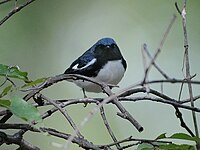
Photo from wikipedia
Despite the generally low level of inter-population genetic differentiation in humans as compared with great apes, it has long been acknowledged that there is a considerable amount of geographic variations… Click to show full abstract
Despite the generally low level of inter-population genetic differentiation in humans as compared with great apes, it has long been acknowledged that there is a considerable amount of geographic variations in human phenotypes, for example, skin pigmentation, cranial morphology, and soft-tissue facial morphology, to name but a few. Indeed, recent studies have suggested that the extent of inter-population diversity in some human phenotypes is greater than expected from random drift alone. Such an excess of phenotypic diversity is often attributed to adaptation to local environment. However, this account is valid only if populations differ in some ecological aspects that elicit differential selection acting on a given phenotypic feature. Another long-standing hypothesis is the sexual selection hypothesis, which claims that phenotypic diversity arises and/or is maintained owing to variations in preference for mating partners. In this paper, we explore the plausibility of the sexual selection hypothesis by means of computer simulations, in which the inter-population diversity of a quantitative trait is evaluated against the expectation from random drift, using the QST-FST comparison. As possible driving factors of sexual selection, we consider two types of mate-choice preference: preference for the population average and preference for a culturally-transmitted arbitrary trend. Our simulations suggest that sexual selection can, under certain circumstances, maintain and/or generate a detectable amount of inter-population phenotypic diversity, even when populations are ecologically identical and loosely connected to each other by mutual migration. Since mating decisions in humans are considerably affected by social learning, human mate-choice preference may be more readily diversified between populations than in other animals. We suggest, therefore, that some of the observed human phenotypic variations may be better understood as a product of cultural, rather than ecological, diversification.
Journal Title: Journal of theoretical biology
Year Published: 2019
Link to full text (if available)
Share on Social Media: Sign Up to like & get
recommendations!